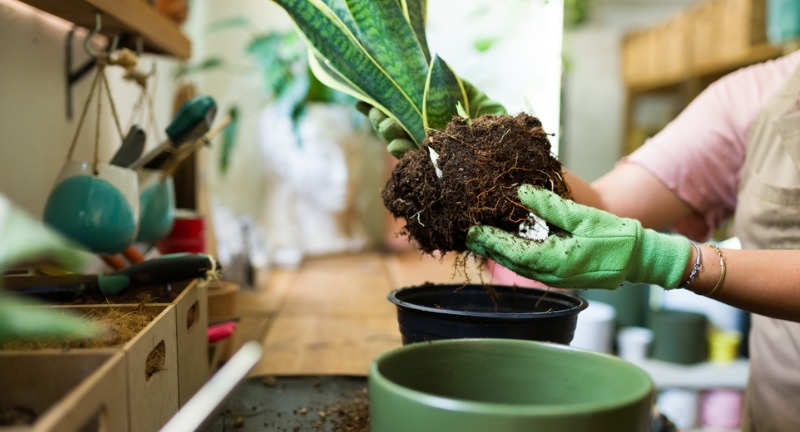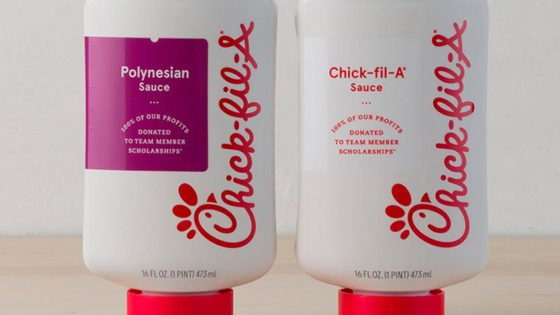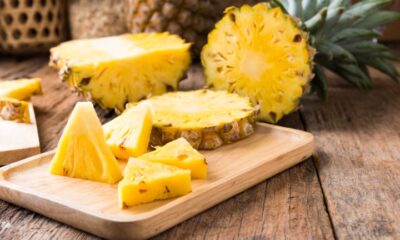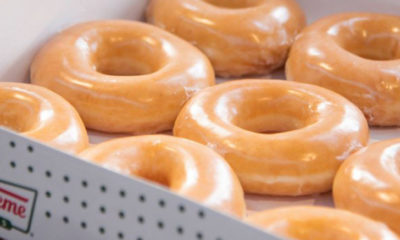FOOD
39 of the Easiest Garden Plants to Grow
Published
2 months agoon

Shutterstock
Whether you’re a green-thumbed guru or someone who’s accidentally killed a cactus (no judgment), there’s a plant on this list that’s perfect for you. From leafy greens to vibrant blooms, these easygoing overachievers will have you saying, “Wow, I did that!” in no time. As a bonus, most of them don’t require endless weeding, watering, or whispering affirmations at dawn.
Snake Plant

Shutterstock
Snake plants are a great first choice for beginners, since they’re tough, resilient, and nearly impossible to kill. With their upright, sword-like leaves, they can thrive in almost any light, from full sun to shady corners, making them perfect for spots where other plants might struggle. They’re not picky about water either, requiring only the occasional drink, and they actually do best when you forget about them for a bit. Aside from their good looks, snake plants are fantastic air purifiers, absorbing toxins and improving indoor air quality. They’re the perfect plant for anyone who wants something that looks sharp and does a little extra work while they kick back and relax.
Basil

Shutterstock
Basil isn’t just a herb; it’s the overachiever of the garden world. Give it a sunny spot and a bit of water, and it’ll reward you with endless fragrant leaves that taste like summer itself. The secret to keeping it happy? Pinch off those flowers before they bloom, and it’ll focus all its energy on growing delicious, leafy goodness. Whether you’re tossing it into a salad, whipping up fresh pesto, or just sniffing it like a weirdo in your kitchen, basil is the plant that keeps on giving.
Parsley

Shutterstock
Parsley is the dependable workhorse of the herb garden—easy to grow and endlessly useful. Whether planted in beds or pots, it thrives in well-drained soil and sunny spots with minimal fuss. Harvesting regularly not only keeps your plant lush but also ensures a steady supply of vibrant, vitamin-packed leaves for garnishing or cooking. It’s an easy win for any gardener, delivering a fresh, bright flavor that’s always ready to elevate your dishes.
Oregano

Shutterstock
This hardy herb thrives in poor soil and warm climates, practically laughing in the face of neglect. Its robust, savory flavor makes it a staple for sauces, marinades, and, of course, anything Italian. And here’s the best part: if you forget to water it, oregano will probably thank you for the break. This is because oregano is drought-tolerant, meaning it thrives with minimal watering once established. Truly, it’s the laid-back friend every garden needs.
Nasturtiums

Shutterstock
Nasturtiums are the garden’s spicy little secret. These vibrant flowers come in shades of orange, red, and yellow, with edible leaves and blooms that pack a peppery punch—great for salads or as a fun garnish. They’re super easy to grow, thriving in poor soil where other plants might struggle, so they’re basically the “I don’t need fancy soil” overachievers of the flower world. Nasturtiums love the sun and don’t ask for much—just a little space to spread out. And let’s be honest, who doesn’t want a flower that’s both beautiful and delicious?
Dill

Shutterstock
Dill is a garden favorite that’s as versatile as it is easy to grow. This feathery herb thrives in well-drained soil with plenty of sunlight, quickly producing fragrant leaves and delicate yellow flowers. Its fresh, tangy flavor makes it a must-have for pickling, seafood dishes, and sauces. As a little bonus, dill also serves as a host plant for swallowtail caterpillars, so your garden might double as a butterfly nursery while you enjoy its culinary benefits.
Cilantro

Shutterstock
Cilantro practically sprints to maturity, rewarding you with fresh, zesty leaves perfect for tacos, curries, or a salsa that will make your chips sing. Keep it in a sunny spot and harvest frequently to keep it from bolting. Bolting occurs when a plant shifts from producing leaves to flowering and seed production. And if it does bolt? No worries; you’ll get coriander seeds out of the deal. It’s the herb that gives you a two-for-one!
Pansies

Shutterstock
Pansies are the quirky charmers of the flower world, with their “faces” that almost seem to smile at you from the garden. These colorful flowers love cool weather, making them perfect for early spring or fall planting. Pansies come in a rainbow of hues, often with unique patterns, like a little piece of art right in your garden. They’re low-maintenance and thrive in both sun and partial shade, which makes them adaptable for various garden spots. With their fun personalities and easy care, pansies are like the garden’s version of a cheerful friend who always knows how to brighten your day.
Spinach

Shutterstock
Not only is it packed with nutrients, but this leafy green is also a breeze to grow. It thrives in cooler temperatures, so you can plant it early in the spring or even in the fall—perfect for gardeners who aren’t exactly fans of the blazing sun. Spinach is one of those “plant and forget” types; just give it some water and watch it grow. Plus, it’s quick—within 30 to 45 days, you’ll have fresh leaves ready to munch on. Just be sure to harvest it regularly; because the more you pick, the more it’ll grow, like a green snack machine!
Morning Glories

Shutterstock
Morning glories are the early risers of the flower world—literally! These climbers love the sun and will reward you with stunning blooms that unfurl each morning, only to fade by the afternoon. With their vibrant blue, purple, or pink petals, they bring a burst of color to fences, trellises, and arbors. They’re super easy to grow and practically beg to climb and spread, making them perfect for adding a touch of drama to your garden. Just be sure to give them something to climb, or they’ll start looking for trouble (a.k.a. your other plants). Morning glories might be a little on the rebellious side, but their beauty and boldness are totally worth it.
Kale

Shutterstock
This superfood loves cooler weather, so it’s perfect for spring or fall gardens, and it’s remarkably resilient to pests and disease. With minimal care, kale will reward you with fresh, nutrient-packed leaves that can be used in salads, smoothies, soups, or even baked into crispy chips (who knew healthy could taste so good?). The best part? Kale is a cut-and-come-again plant, meaning the more you harvest, the more it grows—kind of like a garden subscription service for endless healthy greens. So, if you want a plant that will stay strong through almost any weather, kale’s your green buddy.
Radishes

Shutterstock
Radishes are the speedy sprinters of the garden world. You’ll see these little guys popping up in just 25 to 30 days, making them perfect for impatient gardeners. Radishes thrive in cooler weather and can be planted in spring or fall. They’re low-maintenance, needing just a bit of water and well-drained soil. Plus, they come in a variety of colors, from classic red to purple and even white. Quick to grow, easy to care for, and fun to pull out of the ground—radishes are perfect for beginners and seasoned gardeners alike!
Calendula

Shutterstock
With their bright orange and yellow petals, calendulas are not just pretty faces—they also have a reputation for being a natural remedy for skin irritation. Plant them in well-drained soil with full sun, and in about 55 to 75 days, you’ll be rewarded with these cheerful blooms. They’re easy to grow, requiring little maintenance, and they’re great at attracting beneficial insects like bees and butterflies. Calendulas can even be dried and turned into soothing balms, so not only do they brighten up your garden, but they might just help you with a skincare routine, too!
Carrots

Shutterstock
Carrots are the secret snack heroes of the garden. Plant them, give them a little space, and they’ll reward you with crunchy, vibrant roots. They love loose, sandy soil, so make sure they have room to grow deep. While they do take a bit longer to mature—usually 60 to 80 days—it’s totally worth the wait. Plus, they come in fun colors like purple, yellow, and even white! Whether you eat them raw, roasted, or tossed in a salad, growing your own carrots makes you feel like a garden superstar. It’s like finding treasure, but you get to eat it!
Jade Plant

Shutterstock
Jade plants are the low-maintenance, good-luck charm of the succulent world. With their thick, glossy leaves, they thrive in bright light and need very little water—perfect for busy or forgetful gardeners. This hardy plant is known for its resilience, bouncing back even if you neglect it for a while. Plus, jade plants are said to bring good fortune and prosperity, so you might just get a little extra luck with this one in your garden. A simple, stylish plant that requires little effort but delivers big rewards!
Cucumbers

Shutterstock
Cucumbers are the cool, easygoing buddies of your garden. Plant them in warm soil with lots of sun, and they’ll happily vine out and start producing crisp, refreshing morsels in about 50 to 70 days. These plants are low-maintenance, needing only regular watering and a little space to sprawl. No matter where or how you plant them, cucumbers always seem to thrive, often producing more than you can eat—and perfect for pickling or tossing in a salad.
Strawberries

Shutterstock
These plants love the sun and are pretty easygoing, as long as you give them a spot with well-drained soil. Once they’re established, they’ll start producing juicy, red berries in about 4 to 6 weeks. Plus, they’re perennials, meaning they’ll come back year after year, so you get a fresh batch of berries every spring. Just make sure to mulch around them to keep the soil moist and protect those sweet gems from pests. Growing your own strawberries feels like having your own personal candy store—minus the guilt!
Rosemary

Shutterstock
Rosemary’s fragrant needles are perfect for seasoning everything from roasted meats to potatoes, and its woody stems make for lovely natural skewers for grilling. Plus, it’s a perennial, meaning you’ll get to enjoy its flavor year after year. Rosemary is the perfect plant for anyone who wants to add a touch of culinary magic to their garden—just be careful, it might make you want to become a chef!
Blueberries

Shutterstock
Blueberries thrive in acidic soil, so a little prep work is needed, but once they’re settled, they’ll happily produce fruit year after year. In about 2 to 3 years, you’ll see berries start to appear, and in about 5 to 6 years, you’ll have a full crop. They need full sun and regular watering, but they don’t ask for much else. Plus, they’re pretty forgiving about pests, making them a joy to grow. With a little patience, you’ll have a berry patch that makes you feel like a gardening expert!
Sunflowers

Shutterstock
Sunflowers are the cheerful giants of the garden, and they’re as easygoing as they are tall. Plant them in a sunny spot with well-drained soil, and watch them reach for the sky. In about 70 to 85 days, you’ll have big, bright blooms that are sure to make you smile. They’re low-maintenance, needing just a little water and space to stretch out. Plus, sunflowers are a garden favorite for pollinators, so you’ll get bonus points for helping the bees. Once they’re done blooming, you can even harvest the seeds for a tasty snack. Sunflowers are basically the garden’s feel-good, all-around superstar!
Thyme

Shutterstock
This sun-loving perennial thrives in dry, well-drained soil and asks for little more than occasional trimming. Its tiny, aromatic leaves are a culinary powerhouse, adding earthy, savory notes to everything from roasts to soups. Plus, thyme isn’t just a kitchen hero—it doubles as a natural insect repellent, making it a practical and easy-to-grow addition to any garden.
Marigolds

Shutterstock
Marigolds are the garden’s fiery little performers, bursting with color and personality. These flowers thrive in almost any soil and love full sun, making them perfect for beginners who want instant garden gratification. In just 45 to 60 days, they’ll burst into vibrant orange, yellow, or red blooms, adding an instant pop of color. Not only do marigolds look great, but they also help keep pests away, acting like a natural insect repellent for your garden. They’re the perfect companion plant, adding beauty and function without demanding too much attention. Plus, they’re tough as nails, bouncing back even after a hot summer day.
Zinnias

Shutterstock
These cheerful flowers love the sun and thrive in well-drained soil, blooming in a dazzling array of colors from pink to orange to purple. Zinnias grow quickly, usually flowering in about 60 days, and they’re perfect for brightening up borders, containers, or flower beds. They don’t mind a little heat and are super low-maintenance, making them a go-to choice for busy gardeners. Plus, they’re fantastic for attracting butterflies, so your garden becomes a lively, colorful haven. If you’re looking for flowers that bring both beauty and a pop of personality, zinnias are your go-to!
Tomatoes

Shutterstock
Tomatoes are the garden royalty, and they know it. While they may require a bit more TLC than some other veggies, the payoff is worth it. In about 60 to 85 days, you’ll have juicy, red (or yellow, or purple!) gems ready to pluck. They do need some support, like stakes or cages, to keep those heavy fruits off the ground. But once they start ripening, you’ll feel like a garden champion—nothing beats the taste of a homegrown tomato, whether in a salad, sandwich, or straight off the vine!
Petunias

Shutterstock
Petunias are the garden’s party animals, always ready to add some color and fun wherever they go. These vibrant flowers love the sun and are known for their bold, wide range of colors—think everything from hot pink to purple to soft pastels. They’re low-maintenance, as long as they get plenty of sun and a bit of water now and then. Petunias bloom all season long, giving your garden a non-stop show. Plus, they’re fantastic for hanging baskets or window boxes, where they can trail beautifully over the edges. If you want flowers that are always in a good mood and make your garden look like a celebration, petunias are the way to go.
Cosmos

Shutterstock
These easy-to-grow blooms thrive in full sun and well-drained soil, and they’ll happily self-seed, coming back year after year. With vibrant colors like pink, purple, and white, they give off a wildflower vibe that fits perfectly in any garden setting. Cosmos grow quickly and bloom all summer long, attracting butterflies and bees, which means your garden will be buzzing with life. They’re the kind of flowers that don’t demand much but always manage to look fabulous, like the cool, breezy friends who show up and instantly brighten the room.
Turnips

Shutterstock
Turnips are the hearty, easy-to-grow root veggies that don’t ask for much—just a bit of space, well-drained soil, and a little watering. They grow quickly, with the edible roots ready in about 50 to 60 days. These cool-weather crops are perfect for spring or fall, and their peppery, slightly sweet flavor adds a nice kick to soups, stews, and roasts. Turnips are great for beginners, as they’re low-maintenance and pretty forgiving. Plus, their greens are edible too, making them a double threat in the garden!
Raspberries

Shutterstock
Raspberries are the garden’s sweet reward for a little patience. These hardy plants thrive in well-drained soil and full sun, and while they do take a bit of time to establish—usually 2 years before they really start producing—they’re totally worth the wait. Once they get going, they’ll send up tall canes that yield clusters of juicy, tangy berries. Like strawberries, raspberries are perennials, so they’ll come back each year, and if you prune them right, they’ll keep producing for years. They’re a bit like the “slow and steady” plant—put in the work now, and soon you’ll be enjoying a bountiful harvest! Plus, picking fresh raspberries straight from the bush is a moment of pure garden joy.
Hostas

Shutterstock
Hostas are the low-key, reliable garden favorites that thrive in shade, making them perfect for those tricky spots where the sun refuses to shine. These leafy wonders come in a variety of sizes and colors, from deep green to blue-gray to variegated patterns. While they may not put on an extravagant floral display, their lush foliage creates a gorgeous backdrop that pairs well with pretty much anything. Hostas are super easy to grow, needing only occasional watering and a bit of love to keep those leaves looking their best. They’re like the dependable friend who’s always there, adding calm, cool beauty to your garden without causing a fuss.
Swiss Chard

Shutterstock
With its striking rainbow-colored stems (red, yellow, orange, and white) and broad, crinkly leaves, Swiss chard adds a pop of color (and flavor) to any garden. But don’t let its looks fool you; this plant is incredibly tough and adaptable. It can handle a variety of soils and weather conditions, thriving the best in both spring and fall. Swiss chard is also a bit of a multitasker. You can harvest the leaves while they’re young for tender greens or let them grow a little larger for a heartier bite. Either way, it’s a fast grower, often ready to harvest in about 50 to 60 days.
Daylilies

Shutterstock
These tough, reliable plants bloom in a dazzling array of colors, and while each individual bloom lasts only one day (hence the name), they produce so many buds that your garden will be in constant bloom. Daylilies love full sun but are pretty adaptable, thriving in most soil types with minimal care. They’re perfect for beginners because they’re nearly impossible to kill—seriously, you could forget to water them for a week, and they’d still bounce back. Daylilies are like that friend who’s always up for anything and never needs much attention but still manages to steal the show.
Lavender

Shutterstock
Lavender is the garden’s calming, fragrant superstar. With its lovely purple spikes and soothing scent, it’s perfect for adding a touch of elegance and relaxation to any garden. Lavender thrives in full sun and well-drained soil, and once it’s established, it’s pretty drought-tolerant, making it a low-maintenance beauty. It’s great for attracting pollinators like bees and butterflies, and it even works wonders for your health, with many using it in teas or essential oils for its calming properties. Plus, when you brush up against it, the smell alone will make you feel like you’re in a spa. Lavender’s the plant that works hard while making you feel relaxed—talk about multitasking!
Chives

Shutterstock
Chives are a must-have for any gardener, offering both practicality and charm. These hardy perennials thrive with minimal effort, adapting well to various soil conditions and adding a mild onion flavor to countless dishes. Their delicate purple flowers aren’t just eye-catching—they’re edible, too, making them a versatile garnish. Beyond their culinary uses, chives are excellent companions in the garden, attracting beneficial insects that help maintain a healthy ecosystem.
Zucchini

Shutterstock
Zucchini is the garden’s version of a “go big or go home” plant. Once it starts producing, it doesn’t stop—be prepared for a summer squash avalanche. This veggie thrives in warm weather and well-drained soil, and it’s super easy to grow. In just 50 to 60 days, you’ll have plenty of zucchini to toss into stir-fries, bake into bread, or even sneak into brownies (don’t knock it till you try it). Just keep picking the squash when it’s young and tender, or you’ll end up with zucchinis the size of your arm—trust me, they grow fast!
Sage

Shutterstock
Sage is the garden’s go-to herb for adding a savory punch to your meals. It loves full sun and well-drained soil, and once established, it’s a low-maintenance plant that can handle dry conditions. With its fragrant, silvery leaves, sage is perfect for cooking, especially in dishes like stuffing or roasted meats. Plus, it’s a perennial, so you’ll get fresh leaves year after year. Sage is the reliable herb that doesn’t ask for much but always delivers in flavor!
Aloe Vera

Shutterstock
Aloe vera is the tough, no-fuss plant with a soothing touch. This succulent loves the sun and needs minimal water, making it perfect for forgetful gardeners. Not only does it look great in any garden, but its gel-filled leaves can be used to soothe burns and skin irritations. Aloe vera’s low-maintenance nature and practical benefits make it a win-win—beautiful, helpful, and basically impossible to kill. Plus, it’s like having a natural first aid kit right in your garden!
Pothos

Shutterstock
Pothos grow quickly, adding a lush, green look to any space, and their trailing vines make them perfect for hanging baskets or draping off shelves. Plus, they’re natural air purifiers, cleaning up the indoor air while looking effortlessly cool. If you want a plant that’s as low-maintenance as it is stylish, pothos is your go-to.
Succulents

Shutterstock
Succulents are the garden’s chill, sun-loving crowd-pleasers. With their thick, fleshy leaves, they store water, which means they need very little attention and can thrive on neglect—just give them plenty of sunlight and occasional watering. These plants come in all shapes and sizes, adding texture and personality to any space. Whether they’re in a garden bed, a cute pot, or a hanging planter, succulents are practically designed to look good with minimal effort. They’re perfect for anyone looking for a no-fuss way to add greenery to their life!
Sweet Potatoes

Shutterstock
Sweet potatoes are the garden’s tasty treasure that’s surprisingly easy to grow. They love warm weather and need well-drained soil, but once you plant them, they’ll quickly start sprawling out, creating a beautiful ground cover. In about 90 to 120 days, you’ll have a bounty of sweet, earthy tubers ready to harvest. They’re pretty low-maintenance, requiring only occasional watering and a little space to stretch. Sweet potatoes are not only delicious but also versatile, perfect for roasting, mashing, or even baking into pies. They’re the kind of plant that makes you feel like a gardening pro when harvest time comes around!
Conclusion

Shutterstock
There you have it—plants so easy to grow they’re practically begging to be part of your garden squad. Whether you’re dreaming of fresh herbs for your kitchen, colorful flowers for your yard, or veggies you don’t need a Ph.D. in horticulture to grow, these picks are your fast pass to garden success. And if one or two don’t make it? Just call it “composting” and try again next season. Gardening is all about learning, enjoying, and occasionally laughing at your own mistakes. Now grab those gardening gloves (or don’t, it’s your garden), and let’s get planting!
Related Topics:

More From Lifestylogy
-


Chick-fil-A’s Famous Sauce is Coming to Grocery Stores Nationwide
-


Why Pineapple May Just Be Perfect On Pizza
-


Starbucks Planning More Price Hikes
-


Krispy Kreme Giving Free Donuts to Blood Donors
-


Three Brand New Flavors Coming to Chips Ahoy
-


McDonald’s Bringing Back Spicy Chicken McNuggets
-


25 Fruits That Last The Longest After Purchase
-


Taco Bell Entering the Fried Chicken Wars
-


The Easy Trick to Making Scrambled Eggs Extra Delicious